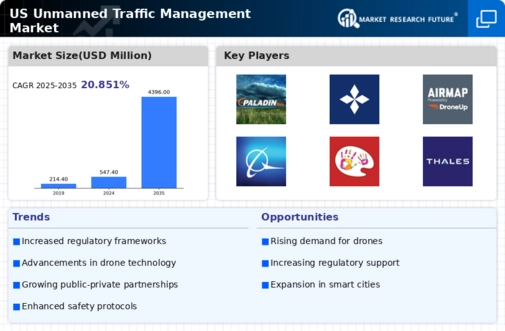Emerging Safety Regulations
The emergence of safety regulations is significantly influencing the unmanned traffic-management market. Regulatory bodies are increasingly focused on establishing guidelines that govern the operation of unmanned aerial vehicles (UAVs) to ensure public safety. The FAA has introduced several initiatives aimed at creating a regulatory framework for UAV operations, which is expected to evolve as the technology matures. This regulatory landscape is likely to drive innovation within the unmanned traffic-management market industry, as companies strive to develop compliant systems that enhance safety and operational efficiency. The alignment of technology with regulatory requirements may also foster greater public acceptance of unmanned systems.
Growing Commercial Applications
The expansion of commercial applications for unmanned aerial vehicles is a significant driver for the unmanned traffic-management market. Industries such as logistics, agriculture, and surveillance are increasingly adopting UAVs for various operational needs. The market for commercial drones in the US is expected to reach $14 billion by 2025, highlighting the potential for growth in this sector. As these applications proliferate, the demand for effective traffic management solutions will intensify. The unmanned traffic-management market industry must adapt to accommodate the diverse needs of commercial users, ensuring that airspace is utilized efficiently and safely.
Increased Demand for Air Mobility
The unmanned traffic-management market is experiencing heightened demand due to the growing interest in air mobility solutions. As urban areas become congested, stakeholders are exploring alternatives such as drones and air taxis. The Federal Aviation Administration (FAA) has projected that the number of commercial drones in the US could reach 1.5 million by 2025, indicating a robust market potential. This surge in demand necessitates sophisticated traffic management systems to ensure safety and efficiency in airspace. The unmanned traffic-management market industry is thus positioned to play a crucial role in facilitating the integration of these aerial vehicles into existing air traffic frameworks, ensuring that operations are seamless and compliant with regulations.
Investment in Infrastructure Development
Investment in infrastructure is a critical driver for the unmanned traffic-management market. As cities and states allocate funds for modernizing transportation systems, there is a growing recognition of the need for advanced traffic management solutions. The US government has earmarked approximately $1 trillion for infrastructure improvements over the next decade, which includes provisions for unmanned traffic management systems. This financial commitment is likely to enhance the capabilities of the unmanned traffic-management market industry, enabling the development of integrated systems that can manage both manned and unmanned vehicles effectively. Such investments are essential for creating a safe and efficient transportation ecosystem.
Technological Integration with Smart Cities
The integration of unmanned traffic management systems with smart city initiatives is a pivotal driver for the market. As cities adopt smart technologies to enhance urban living, the need for efficient traffic management becomes paramount. The unmanned traffic-management market industry is poised to benefit from this trend, as systems that utilize real-time data analytics and IoT connectivity can optimize traffic flow and reduce congestion. According to recent studies, smart city investments in the US are projected to exceed $100 billion by 2025, creating a fertile ground for the deployment of advanced unmanned traffic management solutions that align with urban development goals.

















Leave a Comment